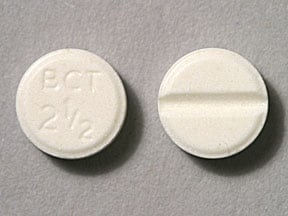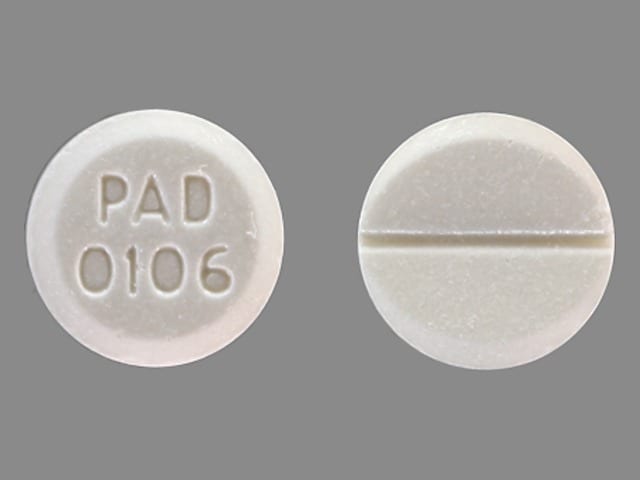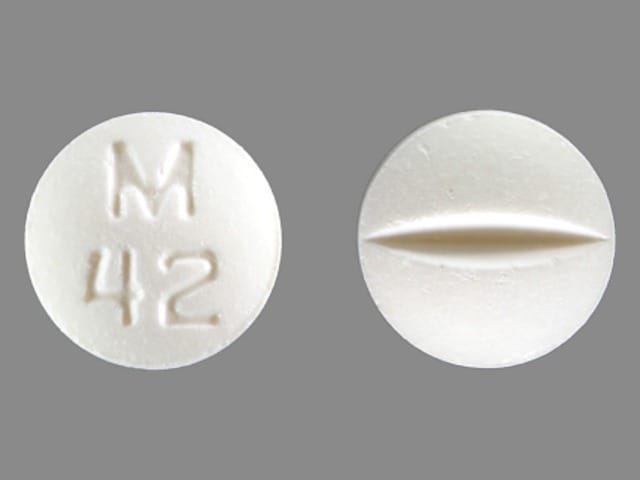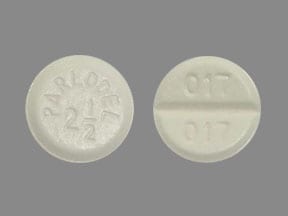Dosage Forms
Excipient information presented when available (limited, particularly for generics); consult specific product labeling.
Capsule, Oral:
Parlodel: 5 mg
Generic: 5 mg
Tablet, Oral:
Cycloset: 0.8 mg
Parlodel: 2.5 mg [scored]
Generic: 2.5 mg
Pharmacology
Mechanism of Action
Semisynthetic ergot alkaloid derivative and a sympatholytic dopamine D2 receptor agonist which activates postsynaptic dopamine receptors in the tuberoinfundibular (inhibiting pituitary prolactin secretion) and nigrostriatal pathways (enhancing coordinated motor control).
In the treatment of type 2 diabetes mellitus, the mechanism of action is unknown; however, bromocriptine is believed to affect circadian rhythms which are mediated, in part, by dopaminergic activity, and are believed to play a role in obesity and insulin resistance. It is postulated that bromocriptine (when administered during the morning and released into the systemic circulation in a rapid, 'pulse-like' dose) may reset hypothalamic circadian activities which have been altered by obesity, thereby resulting in the reversal of insulin resistance and decreases in glucose production, without increasing serum insulin concentrations (Gaziano 2010; Pijl 2000).
Pharmacokinetics/Pharmacodynamics
Distribution
Vd: ~61L
Metabolism
Primarily hepatic via CYP3A; extensive first-pass biotransformation (Cycloset: ~93%)
Excretion
Feces (~82%); urine (2% to 6%)
Time to Peak
Serum: Cycloset: 53 minutes; Parlodel: 2.5 ± 2 hours
Duration of Action
8 to12 hours
Half-Life Elimination
Cycloset: ~6 hours; Parlodel: 4.85 hours
Protein Binding
90% to 96% (primarily albumin)
Use in Specific Populations
Special Populations: Hepatic Function Impairment
Plasma levels may increase with hepatic impairment.
Use: Labeled Indications
Acromegaly (excluding Cycloset): Treatment of acromegaly
Diabetes mellitus, type 2 (Cycloset only): To improve glycemic control in adults with type 2 diabetes mellitus as an adjunct to diet and exercise
Hyperprolactinemia (excluding Cycloset): Treatment of prolactin-secreting pituitary adenoma or disorders associated with hyperprolactinemia including amenorrhea with or without galactorrhea, hypogonadism, or infertility
Parkinson disease (excluding Cycloset): Treatment of the signs and symptoms of idiopathic or postencephalitic Parkinson disease; as adjunctive treatment to levodopa (alone or with a peripheral decarboxylase inhibitor)
Use: Off Label
Neuroleptic malignant syndrome c
Data from a limited number of patients studied (case reports) suggest that bromocriptine may be beneficial for the treatment of neuroleptic malignant syndrome Rosenberg 1989, Strawn 2007. Additional data may be necessary to further define the role of bromocriptine in this condition.
Contraindications
Hypersensitivity to bromocriptine, ergot alkaloids, or any component of the formulation
Additional product-specific contraindications:
Cycloset: Syncopal migraine; breast-feeding
Parlodel: Uncontrolled hypertension; pregnancy (risk to benefit evaluation must be performed in women who become pregnant during treatment for acromegaly, prolactinoma, or Parkinson disease - hypertension during treatment should generally result in efforts to withdraw); postpartum women with a history of coronary artery disease or other severe cardiovascular conditions (unless withdrawal of medication is medically contraindicated)
Dosage and Administration
Dosing: Adult
Acromegaly: Oral: Initial: 1.25 to 2.5 mg daily increasing by 1.25 to 2.5 mg daily as necessary every 3 to 7 days; usual dose: 20 to 30 mg daily (maximum: 100 mg/day).
Diabetes mellitus, type 2 (Cycloset only): Oral: Note: Agents other than bromocriptine are recommended for treatment of patients with type 2 diabetes mellitus (ADA 2019).
Initial: 0.8 mg once daily in the morning; may increase at weekly intervals in 0.8 mg increments as tolerated; usual dose: 1.6 to 4.8 mg once daily (maximum: 4.8 mg/day).
Cycloset dosing adjustment for concomitant therapy:
Moderate CYP3A4 inhibitor (eg, erythromycin): Maximum: 1.6 mg/day.
Strong CYP3A4 inhibitors (eg, azole antimycotics, HIV protease inhibitors): Avoid concomitant use and ensure adequate washout of the strong CYP3A4 inhibitor prior to bromocriptine initiation.
Hyperprolactinemia: Oral: Initial: 1.25 to 2.5 mg daily; may be increased by 2.5 mg daily as tolerated every 2 to 7 days until optimal response (range: 2.5 to 15 mg/day).
Parkinsonism: Oral: 1.25 mg twice daily, increased by 2.5 mg daily in 2- to 4-week intervals as needed (maximum: 100 mg/day).
Neuroleptic malignant syndrome (off-label use): Oral: 2.5 mg (orally or via gastric tube) every 8 to 12 hours, increased to a maximum of 45 mg daily, if needed; continue therapy until NMS is controlled, then taper slowly (Gortney 2009; Strawn 2007).
Dosing: Geriatric
Refer to adult dosing.
Dosing: Pediatric
Hyperprolactinemia secondary to pituitary adenoma:
Children and Adolescents <16 years: Limited data available in age <11 years: Oral: Initial: 1.25 to 2.5 mg daily; dosage may be increased as tolerated to achieve a therapeutic response; usual effective range: 5 to 7.5 mg/day in divided doses; maximum daily dose: 10 mg/day (Fideleff 2009; Gillam 2004)
Adolescents ≥16 years: Oral: Initial: 1.25 to 2.5 mg daily; may be increased by 2.5 mg daily as tolerated every 2 to 7 days until optimal response; usual effective range: 5 to 7.5 mg/day in divided doses; maximum daily dose: 15 mg/day (Fideleff 2009; Gillam 2004)
Administration
Administer with food to decrease GI distress.
Cycloset: Administer within 2 hours of waking in the morning. If the morning dose is missed, wait until the next morning and resume with the usual dose.
Dietary Considerations
Administer with food to decrease GI distress.
Storage
Store below 20°C to 25°C (68°F to 77°F).
Bromocriptine Images
Drug Interactions
Alcohol (Ethyl): May enhance the adverse/toxic effect of Bromocriptine. Bromocriptine may enhance the adverse/toxic effect of Alcohol (Ethyl). Monitor therapy
Alfuzosin: May enhance the hypotensive effect of Blood Pressure Lowering Agents. Monitor therapy
Alizapride: May diminish the therapeutic effect of Anti-Parkinson Agents (Dopamine Agonist). Avoid combination
Alpha-/Beta-Agonists: Ergot Derivatives may enhance the hypertensive effect of Alpha-/Beta-Agonists. Ergot Derivatives may enhance the vasoconstricting effect of Alpha-/Beta-Agonists. Avoid combination
Alpha1-Agonists: Ergot Derivatives may enhance the hypertensive effect of Alpha1-Agonists. Ergot Derivatives may enhance the vasoconstricting effect of Alpha1-Agonists. Avoid combination
Alpha-Lipoic Acid: May enhance the hypoglycemic effect of Antidiabetic Agents. Monitor therapy
Amifostine: Blood Pressure Lowering Agents may enhance the hypotensive effect of Amifostine. Management: When amifostine is used at chemotherapy doses, blood pressure lowering medications should be withheld for 24 hours prior to amifostine administration. If blood pressure lowering therapy cannot be withheld, amifostine should not be administered. Consider therapy modification
Amisulpride: May diminish the therapeutic effect of Anti-Parkinson Agents (Dopamine Agonist). Anti-Parkinson Agents (Dopamine Agonist) may diminish the therapeutic effect of Amisulpride. Avoid combination
Androgens: May enhance the hypoglycemic effect of Blood Glucose Lowering Agents. Exceptions: Danazol. Monitor therapy
Antipsychotic Agents (First Generation [Typical]): May diminish the therapeutic effect of Anti-Parkinson Agents (Dopamine Agonist). Anti-Parkinson Agents (Dopamine Agonist) may diminish the therapeutic effect of Antipsychotic Agents (First Generation [Typical]). Management: Avoid concomitant therapy if possible and monitor for decreased effects of both agents when these combinations cannot be avoided. Atypical antipsychotics such as clozapine and quetiapine may be less likely to reduce the effects of anti-Parkinson agents. Consider therapy modification
Antipsychotic Agents (Second Generation [Atypical]): May diminish the therapeutic effect of Anti-Parkinson Agents (Dopamine Agonist). Management: Consider using an alternative antipsychotic agent when possible in patients with Parkinson disease. If an atypical antipsychotic is necessary, consider using clozapine or quetiapine, which may convey the lowest interaction risk. Consider therapy modification
Barbiturates: May enhance the hypotensive effect of Blood Pressure Lowering Agents. Monitor therapy
Beta-Blockers: May enhance the vasoconstricting effect of Ergot Derivatives. Consider therapy modification
Blood Pressure Lowering Agents: May enhance the hypotensive effect of Hypotension-Associated Agents. Monitor therapy
Brimonidine (Topical): May enhance the hypotensive effect of Blood Pressure Lowering Agents. Monitor therapy
Bromopride: May diminish the therapeutic effect of Anti-Parkinson Agents (Dopamine Agonist). Monitor therapy
Bromperidol: Blood Pressure Lowering Agents may enhance the hypotensive effect of Bromperidol. Bromperidol may diminish the hypotensive effect of Blood Pressure Lowering Agents. Avoid combination
BuPROPion: Anti-Parkinson Agents (Dopamine Agonist) may enhance the adverse/toxic effect of BuPROPion. Monitor therapy
Chloroprocaine: May enhance the hypertensive effect of Ergot Derivatives. Monitor therapy
Clofazimine: May increase the serum concentration of CYP3A4 Substrates (High risk with Inhibitors). Monitor therapy
Conivaptan: May increase the serum concentration of CYP3A4 Substrates (High risk with Inhibitors). Avoid combination
CYP3A4 Inhibitors (Moderate): May increase the serum concentration of Bromocriptine. Management: The bromocriptine dose should not exceed 1.6 mg daily with use of a moderate CYP3A4 inhibitor. The Cycloset brand specifically recommends this dose limitation, but other bromocriptine products do not make such specific recommendations. Consider therapy modification
CYP3A4 Inhibitors (Strong): May increase the serum concentration of Bromocriptine. Exceptions: Nefazodone. Avoid combination
Diazoxide: May enhance the hypotensive effect of Blood Pressure Lowering Agents. Monitor therapy
Diethylstilbestrol: May enhance the adverse/toxic effect of Bromocriptine. Specifically, the risk for amenorrhea may be increased with the combination. Monitor therapy
Direct Acting Antiviral Agents (HCV): May enhance the hypoglycemic effect of Antidiabetic Agents. Monitor therapy
DULoxetine: Blood Pressure Lowering Agents may enhance the hypotensive effect of DULoxetine. Monitor therapy
Erdafitinib: May increase the serum concentration of CYP3A4 Substrates (High risk with Inhibitors). Monitor therapy
Fosaprepitant: May increase the serum concentration of CYP3A4 Substrates (High risk with Inhibitors). Monitor therapy
Fusidic Acid (Systemic): May increase the serum concentration of CYP3A4 Substrates (High risk with Inhibitors). Avoid combination
Guanethidine: May enhance the hypoglycemic effect of Antidiabetic Agents. Monitor therapy
Herbs (Hypotensive Properties): May enhance the hypotensive effect of Blood Pressure Lowering Agents. Monitor therapy
Hyperglycemia-Associated Agents: May diminish the therapeutic effect of Antidiabetic Agents. Monitor therapy
Hypoglycemia-Associated Agents: Antidiabetic Agents may enhance the hypoglycemic effect of Hypoglycemia-Associated Agents. Monitor therapy
Hypotension-Associated Agents: Blood Pressure Lowering Agents may enhance the hypotensive effect of Hypotension-Associated Agents. Monitor therapy
Idelalisib: May increase the serum concentration of CYP3A4 Substrates (High risk with Inhibitors). Avoid combination
Larotrectinib: May increase the serum concentration of CYP3A4 Substrates (High risk with Inhibitors). Monitor therapy
Levodopa-Containing Products: Blood Pressure Lowering Agents may enhance the hypotensive effect of Levodopa-Containing Products. Monitor therapy
Lorcaserin: May enhance the adverse/toxic effect of Ergot Derivatives. Specifically, use of these drugs together may increase the risk of developing valvular heart disease. Lorcaserin may enhance the serotonergic effect of Ergot Derivatives. This could result in serotonin syndrome. Avoid combination
Lormetazepam: May enhance the hypotensive effect of Blood Pressure Lowering Agents. Monitor therapy
Maitake: May enhance the hypoglycemic effect of Blood Glucose Lowering Agents. Monitor therapy
Methylphenidate: May enhance the adverse/toxic effect of Anti-Parkinson Agents (Dopamine Agonist). Monitor therapy
Metoclopramide: May diminish the therapeutic effect of Anti-Parkinson Agents (Dopamine Agonist). Monitor therapy
Molsidomine: May enhance the hypotensive effect of Blood Pressure Lowering Agents. Monitor therapy
Monoamine Oxidase Inhibitors: May enhance the hypoglycemic effect of Blood Glucose Lowering Agents. Monitor therapy
Naftopidil: May enhance the hypotensive effect of Blood Pressure Lowering Agents. Monitor therapy
Nefazodone: Ergot Derivatives may enhance the serotonergic effect of Nefazodone. This could result in serotonin syndrome. Nefazodone may increase the serum concentration of Ergot Derivatives. Avoid combination
Nicergoline: May enhance the hypotensive effect of Blood Pressure Lowering Agents. Monitor therapy
Nicorandil: May enhance the hypotensive effect of Blood Pressure Lowering Agents. Monitor therapy
Nitroglycerin: Ergot Derivatives may diminish the vasodilatory effect of Nitroglycerin. This is of particular concern in patients being treated for angina. Nitroglycerin may increase the serum concentration of Ergot Derivatives. Avoid combination
Nitroprusside: Blood Pressure Lowering Agents may enhance the hypotensive effect of Nitroprusside. Monitor therapy
Obinutuzumab: May enhance the hypotensive effect of Blood Pressure Lowering Agents. Management: Consider temporarily withholding blood pressure lowering medications beginning 12 hours prior to obinutuzumab infusion and continuing until 1 hour after the end of the infusion. Consider therapy modification
Palbociclib: May increase the serum concentration of CYP3A4 Substrates (High risk with Inhibitors). Monitor therapy
Pegvisomant: May enhance the hypoglycemic effect of Blood Glucose Lowering Agents. Monitor therapy
Pentoxifylline: May enhance the hypotensive effect of Blood Pressure Lowering Agents. Monitor therapy
Pholcodine: Blood Pressure Lowering Agents may enhance the hypotensive effect of Pholcodine. Monitor therapy
Phosphodiesterase 5 Inhibitors: May enhance the hypotensive effect of Blood Pressure Lowering Agents. Monitor therapy
Prostacyclin Analogues: May enhance the hypotensive effect of Blood Pressure Lowering Agents. Monitor therapy
Protease Inhibitors: May increase the serum concentration of Ergot Derivatives. Avoid combination
Prothionamide: May enhance the hypoglycemic effect of Blood Glucose Lowering Agents. Monitor therapy
Quinagolide: May enhance the hypotensive effect of Blood Pressure Lowering Agents. Monitor therapy
Quinolones: May enhance the hypoglycemic effect of Blood Glucose Lowering Agents. Quinolones may diminish the therapeutic effect of Blood Glucose Lowering Agents. Specifically, if an agent is being used to treat diabetes, loss of blood sugar control may occur with quinolone use. Monitor therapy
Reboxetine: May enhance the hypertensive effect of Ergot Derivatives. Monitor therapy
Ritodrine: May diminish the therapeutic effect of Antidiabetic Agents. Monitor therapy
Roxithromycin: May increase the serum concentration of Ergot Derivatives. Avoid combination
Salicylates: May enhance the hypoglycemic effect of Blood Glucose Lowering Agents. Monitor therapy
Selective Serotonin Reuptake Inhibitors: May enhance the hypoglycemic effect of Blood Glucose Lowering Agents. Monitor therapy
Serotonergic Agents (High Risk): Ergot Derivatives may enhance the serotonergic effect of Serotonergic Agents (High Risk). This could result in serotonin syndrome. Management: Monitor for signs and symptoms of serotonin syndrome/serotonin toxicity (eg, hyperreflexia, clonus, hyperthermia, diaphoresis, tremor, autonomic instability, mental status changes) when these agents are combined. Exceptions: Nefazodone. Monitor therapy
Serotonin 5-HT1D Receptor Agonists (Triptans): Ergot Derivatives may enhance the vasoconstricting effect of Serotonin 5-HT1D Receptor Agonists (Triptans). Serotonin 5-HT1D Receptor Agonists (Triptans) may enhance the vasoconstricting effect of Ergot Derivatives. Avoid combination
Simeprevir: May increase the serum concentration of CYP3A4 Substrates (High risk with Inhibitors). Monitor therapy
Solriamfetol: Anti-Parkinson Agents (Dopamine Agonist) may enhance the hypertensive effect of Solriamfetol. Monitor therapy
Somatostatin Analogs: May increase the serum concentration of Bromocriptine. Somatostatin Analogs may also delay bromocriptine absorption and time to maximum plasma concentrations. Monitor therapy
Stiripentol: May increase the serum concentration of CYP3A4 Substrates (High risk with Inhibitors). Management: Use of stiripentol with CYP3A4 substrates that are considered to have a narrow therapeutic index should be avoided due to the increased risk for adverse effects and toxicity. Any CYP3A4 substrate used with stiripentol requires closer monitoring. Consider therapy modification
Sulpiride: May diminish the therapeutic effect of Anti-Parkinson Agents (Dopamine Agonist). Avoid combination
Thiazide and Thiazide-Like Diuretics: May diminish the therapeutic effect of Antidiabetic Agents. Monitor therapy
Adverse Reactions
Note: Frequency of adverse effects may vary by dose and/or indication.
>10%:
Central nervous system: Dizziness, fatigue, headache
Gastrointestinal: Constipation, nausea
Neuromuscular & skeletal: Weakness
Respiratory: Rhinitis
1% to 10%:
Cardiovascular: Hypotension (including postural/orthostatic), Raynaud's phenomenon, syncope, vasospasm (digital)
Central nervous system: Drowsiness, lightheadedness
Endocrine & metabolic: Hypoglycemia (4%; in combination with sulfonylureas or other antidiabetic agents: 7% to 9%)
Gastrointestinal: Abdominal cramps, anorexia, diarrhea, dyspepsia, gastrointestinal hemorrhage, vomiting, xerostomia
Infection: Increased susceptibility to infection
Ophthalmic: Amblyopia
Respiratory: Flu-like symptoms, nasal congestion, sinusitis
Postmarketing and/or case reports: Abdominal distress, acquired valvular heart disease, alopecia, anxiety, ataxia, blepharospasm, blurred vision, bradycardia, cardiac arrhythmia, cerebrovascular accident (postpartum), cold extremities, cold intolerance, confusion, constrictive pericarditis, delusions, depression, dyskinesia, dysphagia, dyspnea, epileptiform seizures, ergot alkaloids toxicity, erythromelalgia, gastrointestinal ulcer, hallucination, heavy headedness, hypersensitivity reaction, hypertension (postpartum), increased cerebrospinal fluid pressure, increased libido, insomnia, lassitude, lethargy, muscle cramps, myocardial infarction (postpartum), narcolepsy, nervousness, nightmares, on-off phenomenon, pallor, paranoia, paresthesia, pericardial effusion, peripheral edema, pleural effusion, pleurisy, psychomotor agitation, psychosis, pulmonary fibrosis, retroperitoneal fibrosis, seizure (postpartum), skin mottling, skin rash, sleep disorder, status epilepticus (postpartum), tachycardia, tingling of the ears, tinnitus, transient blindness, urinary frequency, urinary incontinence, urinary retention, vasodepressor syncope, ventricular tachycardia, vertigo, visual disturbance
Warnings/Precautions
Concerns related to adverse effects:
- Cardiac valvular fibrosis: Ergot alkaloids and derivatives have been associated with fibrotic valve thickening (eg, aortic, mitral, tricuspid); usually associated with long-term, chronic use.
- Cardiovascular effects: Hypotension, including orthostatic hypotension and syncope, may occur, particularly upon initiation of therapy and dose escalation. In addition, hypertension, seizures, MI, and stroke have been reported. Severe headache or visual changes may precede events. The onset of reactions may be immediate or delayed (often may occur in the second week of therapy). Discontinue therapy and evaluate promptly if hypertension, severe, progressive, or unremitting headache (with or without visual disturbance), or evidence of CNS toxicity develops. In a scientific statement from the American Heart Association, bromocriptine has been determined to be an agent that may cause direct myocardial toxicity (magnitude: major) (AHA [Page 2016]).
- CNS depression: May cause CNS depression, which may impair physical or mental abilities, and episodes of sudden sleep onset particularly in patients with Parkinson disease; patients must be cautioned about performing tasks that require mental alertness (eg, operating machinery or driving). Consider dosage reduction or discontinuation of therapy if symptoms occur.
- Hallucinations: Visual or auditory hallucinations may occur when administered alone or concomitantly with levodopa; dose reductions or discontinuation may be necessary. Symptoms may persist for several weeks following discontinuation.
- Impulse control disorders: Dopamine agonists used for Parkinson disease or restless legs syndrome have been associated with compulsive behaviors and/or loss of impulse control, which has manifested as new or increased gambling urges, sexual urges, uncontrolled spending, or other intense urges. Dose reduction or discontinuation of therapy reverses these behaviors in some, but not all cases.
- Melanoma: Risk for melanoma development is increased in Parkinson disease patients; drug causation or factors contributing to risk have not been established. Monitor all patients closely for melanoma and perform periodic skin examinations.
- Pleural/retroperitoneal fibrosis: Cases of pleural and pericardial effusions, as well as pleural, pulmonary, and/or retroperitoneal fibrosis and constrictive pericarditis have been reported with prolonged and high-dose daily use. Discontinue therapy if fibrotic changes are suspected.
Disease-related concerns:
- Acromegaly: Appropriate use: In the treatment of acromegaly, discontinuation is recommended if tumor expansion occurs during therapy. In patients treated with pituitary irradiation, withhold therapy for 4 to 8 weeks on a yearly basis to assess both the clinical effects of radiation on the disease process as well as the effects of bromocriptine. Digital vasospasm (cold sensitive) may occur in some patients with acromegaly; may require dosage reduction.
- Cardiovascular disease: Use with caution in patients with cardiovascular disease (myocardial infarction; residual atrial, nodal, or ventricular arrhythmia).
- Dementia: Use with caution in patients with dementia; high doses may be associated with confusion and mental disturbances.
- Galactose intolerance/malabsorption (Parlodel): Avoid use in patients with rare hereditary problems of galactose intolerance, severe lactase deficiency or glucose-galactose malabsorption.
- Hepatic impairment: Use with caution in patients with hepatic impairment; dosage adjustment may be necessary due to extensive hepatic metabolism.
- Macroadenomas: Discontinuation of therapy in patients with macroadenomas has been associated with rapid regrowth of tumor and increased prolactin serum levels.
- Peptic ulcer disease: Use with caution in patients with peptic ulcer disease; severe gastrointestinal bleeding has been reported (some fatal).
- Prolactin-secreting adenomas: Cerebrospinal fluid rhinorrhea has been observed in some of these patients.
- Psychosis: Use with caution in patients with psychosis; dopamine agonists may exacerbate the disorder or diminish the effectiveness of drugs used to treat the disorder. Use in patients with severe psychotic disorder is not recommended.
Concurrent drug therapy issues:
- Drug-drug interactions: Potentially significant interactions may exist, requiring dose or frequency adjustment, additional monitoring, and/or selection of alternative therapy. Consult drug interactions database for more detailed information.
Dosage form specific issues:
- Interchangeability (Cycloset): Due to a difference in the formulation and resulting pharmacokinetics of Cycloset ("quick-release" tablet) compared to other formulations of bromocriptine, interchangeability with any other bromocriptine product is not recommended in the setting of type 2 diabetes mellitus management.
Other warnings/precautions:
• Appropriate use (Cycloset): Not indicated for use in type 1 diabetes mellitus or diabetic ketoacidosis.
- Discontinuation of therapy: Dopaminergic agents have been associated with a syndrome resembling neuroleptic malignant syndrome on abrupt withdrawal or significant dosage reduction after long-term use; gradual dosage reduction is recommended when discontinuing therapy.
- Visual monitoring: Monitoring and careful evaluation of visual changes during the treatment of hyperprolactinemia is recommended to differentiate between tumor shrinkage and traction on the optic chiasm; rapidly progressing visual field loss requires neurosurgical consultation.
Monitoring Parameters
Blood pressure and heart rate (orthostatic vital signs; baseline and periodically thereafter); hepatic, renal, hematopoietic, and cardiovascular function (periodically); visual fields (prolactinoma; periodic); pregnancy test during amenorrheic period; growth hormone (acromegaly; periodic); prolactin levels; GI bleeding (patients with history of peptic ulcer); melanoma skin examinations (regular assessment)
Diabetes mellitus, type 2: Serum glucose and HbA1c (at least twice yearly in patients who have stable glycemic control and are meeting treatment goals; quarterly in patients not meeting treatment goals or with therapy change [ADA 2019])
Pregnancy
Pregnancy Risk Factor
B
Pregnancy Considerations
Bromocriptine crosses the placenta (Molitch 2015). Data collected from women taking bromocriptine during pregnancy suggest the incidence of birth defects is not increased with use. However, the majority of women discontinued use within 8 weeks of pregnancy.
Bromocriptine should be discontinued if pregnancy is confirmed unless needed for treatment of a rapidly expanding macroadenoma. When used for the treatment of acromegaly or Parkinson disease, consider discontinuing therapy during pregnancy. If treatment is withdrawn, monitor for signs and symptoms of an enlarging prolactin secreting tumor. Regardless of indication, if bromocriptine is needed in a pregnant woman, monitor closely for hypertensive disorders during pregnancy and immediately postpartum.
Women with hyperprolactinemia may be infertile, have amenorrhea and galactorrhea. A mechanical contraceptive should be used during therapy until normal ovulatory menses is established. Contraception can then be discontinued if pregnancy is desired. During treatment with bromocriptine, fertility may occur prior to restoration of menses in infertile women; therefore, a pregnancy test is recommended every 4 weeks during the amenorrheic period. Once menses resume, pregnancy tests should be done any time a menstrual period is missed. Women not seeking pregnancy should be advised to use appropriate contraception.
Patient Education
What is this drug used for?
- It is used to treat acromegaly.
- It is used to treat high prolactin levels.
- It is used to treat Parkinson's disease.
- It is used to treat some prolactin-secreting tumors.
- It is used to lower blood sugar in patients with high blood sugar (diabetes).
- It may be given for other reasons. Talk with the doctor.
Frequently reported side effects of this drug
- Nausea
- Vomiting
- Constipation
- Fatigue
- Loss of strength and energy
- Trouble sleeping
- Stuffy nose
- Runny nose
- Diarrhea
- Lack of appetite
Other side effects of this drug: Talk with your doctor right away if you have any of these signs of:
- Severe cerebrovascular disease like change in strength on one side is greater than the other, trouble speaking or thinking, change in balance, or vision changes
- Low blood sugar like dizziness, headache, fatigue, feeling weak, shaking, fast heartbeat, confusion, increased hunger, or sweating
- Severe dizziness
- Passing out
- Vision changes
- Mood changes
- Behavioral changes
- Chest pain
- Trouble moving
- Severe headache
- Shortness of breath
- Excessive weight gain
- Swelling of arms or legs
- Uncontrollable urges
- Narcolepsy
- Back pain
- Black, tarry, or bloody stools
- Seizures
- Vomiting blood
- Severe abdominal pain
- Sensing things that seem real but are not
- Unable to pass urine
- Change in amount of urine passed
- Confusion
- Signs of a significant reaction like wheezing; chest tightness; fever; itching; bad cough; blue skin color; seizures; or swelling of face, lips, tongue, or throat.
Note: This is not a comprehensive list of all side effects. Talk to your doctor if you have questions.
Consumer Information Use and Disclaimer: This information should not be used to decide whether or not to take this medicine or any other medicine. Only the healthcare provider has the knowledge and training to decide which medicines are right for a specific patient. This information does not endorse any medicine as safe, effective, or approved for treating any patient or health condition. This is only a brief summary of general information about this medicine. It does NOT include all information about the possible uses, directions, warnings, precautions, interactions, adverse effects, or risks that may apply to this medicine. This information is not specific medical advice and does not replace information you receive from the healthcare provider. You must talk with the healthcare provider for complete information about the risks and benefits of using this medicine.








